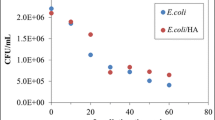Abstract
Photocatalytic activity of UV+visible-activated nitrogen-doped titanium dioxide catalyst was tested for Escherichia coli ATCC 25922 inactivation. A further aspect of this work was to evaluate the effect of selected parameters (pH, irradiation type, and nitrogen-doped TiO2 concentration) on the disinfection efficiency. The following conditions were tested: complete solar radiation (UV–visible) and visible solar radiation alone, four different concentrations of catalyst (0.0, 0.10, 0.25, and 0.5 mg/mL), and six pH values (6.0, 6.5, 7.0, 7.5, 8.0, and 8.5). Dark conditions were used as control experiments. Disinfection process was enhanced under irradiation when the nitrogen-doped photocatalyst was added into the solution. Lower accumulated energy along with higher inactivation rates was observed in the experiments testing nitrogen-doped TiO2 in comparison with the results obtained on the samples without the catalyst. The disinfection effect of the photocatalyst was found depending on the radiation type. pH value has an important role in the inactivation mechanisms that seems to be related with the cell wall permeability and with particle’s surface charge. pH values 6.5 and 8.0 improve the antimicrobial efficiency of the catalyst tested, whereas pH 7 was identified as the less favorable conditions for microbial inactivation.








Similar content being viewed by others
References
Rodrigues CP, Ziolli RL, Guimaraes JR (2007) Inactivation of Escherichia coli in water by TiO2-assisted disinfection using solar light. J Braz Chem Soc 18:126–134
Sichel C, Tello J, de Cara M, Fernández-Ibáñez P (2007) Effect of UV solar intensity and dose on the photocatalytic disinfection of bacteria and fungi. Catal Today 129:152–160
Srinivasan C, Somasundaram N (2003) Bactericidal and detoxification effects of irradiated semiconductor catalyst, TiO2. Curr Sci 85:1431–1438
Popa M, Diamandescu L, Vasiliu F, Teodorescu CM, Cosoceanu V, Baia M, Feder M, Baia L, Danciu V (2009) Synthesis, structural characterization, and photocatalytic properties of iron-doped TiO2 aerogels. J Mater Sci 44:358–364
Muranyi P, Scrami C, Wunderlich J (2009) Antimicrobial efficiency of titanium dioxide-coated surfaces. J Appl Microbiol 108:1966–1973
Pelaez M, de la Cruz AA, Stathatos E, Falaras P, Dionysiou DD (2009) Visible light-activated N-F-codoped TiO2 nanoparticles for the photocatalytic degradation of microcystin-LR in water. Catal Today 144:19–25
Rincón AG, Pulgarín C (2003) Photocatalytical inactivation of E. coli effect of (continuous-intermitent) light intensity and of (suspended-fixed) TiO2 concentration. Appl Catal 44:263–284
Kuhn KP, Chaberny IF, Massholder K, Stickler M, Benz VW, Sontag HG, Erdinger L (2003) Disinfection of surfaces by photocatalytic oxidation with titanium dioxide and UVA light. Chemosphere 53:71–77
Shanmugasundaram S, Kisch H (2003) Daylight photocatalysis by carbon-modified titanium dioxide. Angew Chem Int Ed 42:4908–4911
Mitoraj D, Janczyk A, Strus M, Lisch H, Stochel G, Heczko P, Macyk W (2007) Visible light inactivation of bacteria and fungi by modified titanium dioxide. Photochem Photobiol Sci 6:642–648
Emeline AV, Kuznetsov VN, Rybchuk VK, Serpone N (2008) Visible-light-active titania photocatalysts: the case of N-doped TiO2s-properties and some fundamental issues. Int J Photoenergy 1–19
© Pulles & Hanique B. V. Glass and Ceramics for High-Tech Applications (2006) http://www.pulleshanique.com/05_address.htm
Fernández P, Blanco J, Sichel C, Malato S (2005) Water disinfection by solar photocatalysis using compound parabolic collectors. Catal Today 101:345–356
Rincón AG, Pulgarín C (2004) Effect of pH, inorganic ions, organic matter and H2O2 on E. coli K12 photocatalytic inactivation by TiO2: implications in solar water disinfection. Appl Catal B-Environ Res 51:283–302
Rafellini S, Schenk M, Guerrero S, Alzamora SM (2011) Kinetics of Escherichia coli inactivation employing hydrogen peroxide at varying temperatures, pH and concentrations. Food Control 22:920–932
Lodish H, Berk A, Zipursky L, Matsudaira P, Baltimore D, Darnell J (2000) Molecular cell biology media connected, England
Huang Z, Maness PC, Blake DM, Wolfrum EJ, Smolinski SL, Jacoby WA (2000) Bactericidal mode of titanium dioxide photocatalysis. J Photochem Photobiol A 130:163–170
Madigan M, Martinko J, Parker J (1998) Brock Biología de los microorganismos. Prentice Hall, España
Matsunaga T, Tomoda R, Nakajima T, Wake H (1985) Photoelectrochemical sterilization of microbial cells by semiconductor powder. FEMS Microbiol Lett 29:211–214
Matsunaga T, Tomoda R, Nakajima T, Nakamura N, Komine T (1988) Continuous-sterilization system that uses photosemiconductor powders. Appl Environ Microbiol 54:1330–1333
Imlay J, Fridovich I (1992) Suppression of oxidative envelope damage by pseudoreversion of a superoxide dismutase-deficient mutant of Escherichia coli. J Bacteriol 174:953–961
Acknowledgments
This work was funded by the National Council of Science and Technology of Mexico (CONACyT) grants 91319 and VER-C01-2010-143438. J. Castillo grateful thanks CONACyT and the Universidad de las Americas Puebla (UDLAP) for providing her with a scholarship for pursuing doctoral studies. Authors gratefully thank Dionysios D. Dionysiou and Miguel Pelaez from the Department of Civil and Environmental Engineering, University of Cincinnati, for providing with the nitrogen-doped-TiO2 nanoparticles.
Author information
Authors and Affiliations
Corresponding author
Rights and permissions
About this article
Cite this article
Castillo-Ledezma, J.H., Sánchez Salas, J.L., López-Malo, A. et al. Effect of pH, solar irradiation, and semiconductor concentration on the photocatalytic disinfection of Escherichia coli in water using nitrogen-doped TiO2 . Eur Food Res Technol 233, 825–834 (2011). https://doi.org/10.1007/s00217-011-1579-5
Received:
Revised:
Accepted:
Published:
Issue Date:
DOI: https://doi.org/10.1007/s00217-011-1579-5




